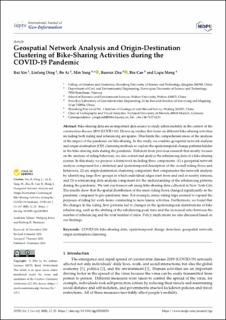| dc.contributor.author | Xin, Rui | |
| dc.contributor.author | Ding, Linfang | |
| dc.contributor.author | Ai, Bo | |
| dc.contributor.author | Yang, Min | |
| dc.contributor.author | Zhu, Ruoxin | |
| dc.contributor.author | Cao, Bin | |
| dc.contributor.author | Meng, Liqiu | |
| dc.date.accessioned | 2023-10-23T11:01:30Z | |
| dc.date.available | 2023-10-23T11:01:30Z | |
| dc.date.created | 2023-03-03T15:08:00Z | |
| dc.date.issued | 2023 | |
| dc.identifier.citation | ISPRS International Journal of Geo-Information. 2023, 12 (1), . | en_US |
| dc.identifier.issn | 2220-9964 | |
| dc.identifier.uri | https://hdl.handle.net/11250/3098038 | |
| dc.description.abstract | Bike-sharing data are an important data source to study urban mobility in the context of the coronavirus disease 2019 (COVID-19). However, studies that focus on different bike-sharing activities including both riding and rebalancing are sparse. This limits the comprehensiveness of the analysis of the impact of the pandemic on bike-sharing. In this study, we combine geospatial network analysis and origin-destination (OD) clustering methods to explore the spatiotemporal change patterns hidden in the bike-sharing data during the pandemic. Different from previous research that mostly focuses on the analysis of riding behaviors, we also extract and analyze the rebalancing data of a bike-sharing system. In this study, we propose a framework including three components: (1) a geospatial network analysis component for a statistical and spatiotemporal description of the overall riding flows and behaviors, (2) an origin-destination clustering component that compensates the network analysis by identifying large flow groups in which individual edges start from and end at nearby stations, and (3) a rebalancing data analysis component for the understanding of the rebalancing patterns during the pandemic. We test our framework using bike-sharing data collected in New York City. The results show that the spatial distribution of the main riding flows changed significantly in the pandemic compared to pre-pandemic time. For example, many riding trips seemed to expand the purposes of riding for work–home commuting to more leisure activities. Furthermore, we found that the changes in the riding flow patterns led to changes in the spatiotemporal distributions of bike rebalancing, such as the shifting of the rebalancing peak time and the increased ratio between the number of rebalancing and the total number of rides. Policy implications are also discussed based on our findings. | en_US |
| dc.language.iso | eng | en_US |
| dc.publisher | MDPI | en_US |
| dc.rights | Navngivelse 4.0 Internasjonal | * |
| dc.rights.uri | http://creativecommons.org/licenses/by/4.0/deed.no | * |
| dc.title | Geospatial Network Analysis and Origin-Destination Clustering of Bike-Sharing Activities during the COVID-19 Pandemic | en_US |
| dc.title.alternative | Geospatial Network Analysis and Origin-Destination Clustering of Bike-Sharing Activities during the COVID-19 Pandemic | en_US |
| dc.type | Peer reviewed | en_US |
| dc.type | Journal article | en_US |
| dc.description.version | publishedVersion | en_US |
| dc.source.volume | 12 | en_US |
| dc.source.journal | ISPRS International Journal of Geo-Information | en_US |
| dc.source.issue | 1 | en_US |
| dc.identifier.doi | 10.3390/ijgi12010023 | |
| dc.identifier.cristin | 2131086 | |
| cristin.ispublished | true | |
| cristin.fulltext | original | |
| cristin.qualitycode | 1 | |

